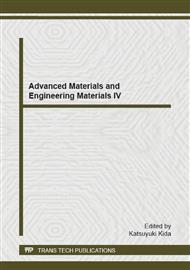p.441
p.451
p.455
p.459
p.463
p.467
p.471
p.475
p.480
Superhydrophobic Polyimide via UV Photo-Oxidation and Fluoroalkyl Silanization: Changes in Surface Chemistry
Abstract:
Topographically rich superhydrophilic surfaces can be generated by UV photo-oxidation of originally flat polyimide. Then stable superhydrophobic PI films can be achieved after fluoroalkylsilane (FAS) modification. Present work describes the changes in surface chemistry during the preparation processes. After UV treatment in air, PI was oxidized accompanied by the generation of OH and amide groups as well as N-O bondings. Moreover, the oxidized polymer tended to aggregate as protrusions, gathering of polar groups such as OH groups. The OH groups could further react with FAS, combining fluoroalkyl chains with irradiated PI through O-Si bondings (silanization). The chemical bindings contributed to the stability of superhydrophobicity.
Info:
Periodical:
Pages:
463-466
Citation:
Online since:
December 2014
Authors:
Price:
Сopyright:
© 2015 Trans Tech Publications Ltd. All Rights Reserved
Share:
Citation:


